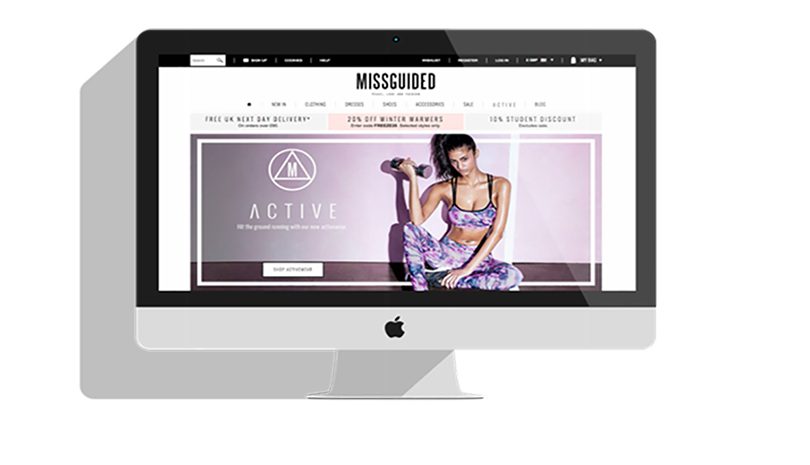No slowing down for rapid fashion retailer

International fashion brand, Missguided, has been operating in Australia and New Zealand for two years, on what it calls “a low key basis”. Now, the company, built on delivering rapid fashion at affordable prices, is aiming to carve out a larger slice of the Australian market.
UK-based Missguided doesn’t yet have a local team, however Victoria Betts, marketing and trading director, was in Australia recently and told Inside Retail Weekly, that’s likely to change in the next six months.
“It’s a really important market for us,” Betts said. “I think we know that there are quite a few UK and US retailers that are prospering over in Australia. We are doing well, but perhaps not as well as we’d like to.”
A lack of brand awareness and the tyranny of distance – Missguided only has one central distribution hub, in the UK – has hindered its Australian efforts. So the company started stepping up its efforts six to 12 months ago, with a strong focus on putting the right infrastructure in place.
Missguided is working with Australia Post on delivery fulfilment and has introduced “in-country returns”, allowing refunds to be processed as soon as Australia Post registers the return, rather than waiting 10-15 days for it to arrive back in the UK.
Missguided was founded in 2008 and espouses the benefits of “rapid fashion”, which ups the ante on fast fashion houses such as H&M and Zara. Betts explained that rapid fashion is two-fold – turning a garment worn on a catwalk or red carpet around in a matter of weeks, and getting product to the customer faster.
“We are starting to turn goods around, some of them in a week, two weeks, without compromising quality,” she said. “We do have an awful lot of products and our average lead time is four to six weeks. However we do turn garments around much more quickly.”
The online operation affords Missguided agility that would not be possible with a normal supply chain. It has also allowed them to implement a unique buying strategy, called “test, react and maximise”.
Betts explained, “Invariably we might sell 1000 pieces of every one garment, but we will buy 200 upfront and we will fly it over from China, we won’t ship it. If it performs well, we’ll then put the existing 800 plus order in or we’ll exceed that to 2000. If it doesn’t do well, we won’t rebuy.
“One of the things some of the larger fashion houses find is to get their cost prices at a more effective route, they’ll order 3000 pieces. Whilst they’re getting a better cost price, it takes them considerably longer to generate 3000 pieces on the factory floor than it does to create the 200.”
Currently 75 per cent of the company’s business is in the UK, but it also operates in the US and Canada, France, Europe and delivers to 160 countries worldwide. Opening new distribution centres to service the US, Asia and Australia is also on the company’s horizon.
Missguided is currently ranged in two bricks and mortar retailers, Selfridges and Nordstrom. It has 2.4 million active customers, 74 per cent of them have shopped twice or more and the average order value is $60.
Betts attributes much of the company’s growth to its successful use of analytics to deliver personalised service solely through digital channels.
“I massively admire my competitors who have a bricks and mortar presence, because their job arguably is harder because they’ve got footfall but they’re not data rich,” she said. “The big reason why, as an online retailer, we can be so effective and have that test and learn approach is because we’ve got data in absolute abundance.”
Just browsing
Betts said it’s natural consumer behaviour to spend more time browsing than buying and 55 per cent of Missguided shoppers browse four times a week. However, valuable data builds up based on sessions, visits and products viewed, before a transaction is even considered.
Betts uses this data to tailor marketing messages to encourage women to shop with Missguided without being too pushy or persuasive, which could lead to costly ‘unsubscribes’ from the Missguided database.
“I don’t have bricks and mortar, but while she’s wandering past the high street, she’s getting an email from me telling her about the new collection that has arrived in her size and in her colour because we know lastly she ordered in a size 10 and she mostly liked black,” Betts said.
Betts said she saw exponential growth when she moved away from ‘broadcast communications’ into more personalised, tailored segmentations over email. Missguided uses Oracle marketing cloud software as its “marketing decision engine”, to deliver the right messages to the right customer, at the right time.
Data-driven observations, for example people that browse on a Tuesday are more likely to buy, soon turned into a hypothesis: what if we could shift people who browse on a Monday to a Tuesday to replicate that behaviour? Each hypothesis the team comes up with, is tested using email marketing.
Apart from email marketing, Missguided delivers personalised service to customers via bespoke virtual shop windows, which look different depending on how consumers arrive at the site. For example, someone who has keyed in the site’s URL has likely seen the Missguided TV ad, so they’ll see similar products as featured on the advertisement. While returning shoppers will be served a landing page based on their tastes.
Despite the effectiveness of hard working data boffins operating invisibly behind the scenes, Betts said it still has to look like a fashion brand.
“When you are selling fashion you’ve got to have a tone of voice, you’ve got to have excitement, you’ve got to have emotion.”
This story first appeared in Internet Retailing’s sister site Inside Retail, click here to subscribe.
Comment Manually
You must be logged in to post a comment.

No comments